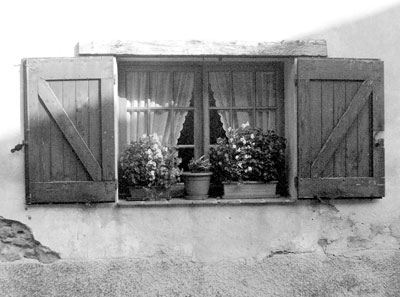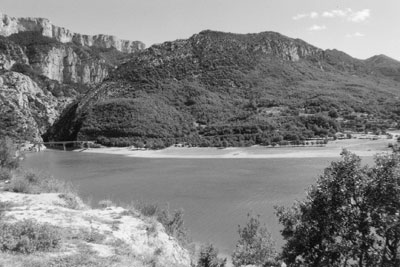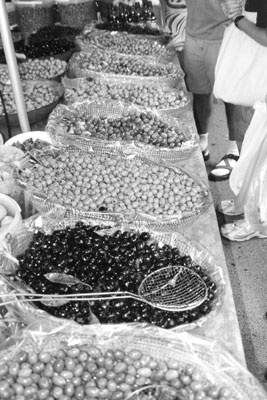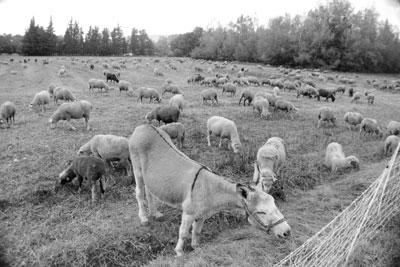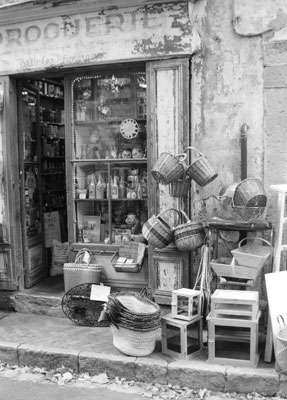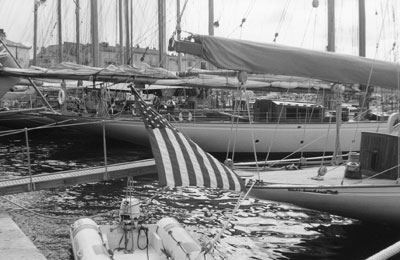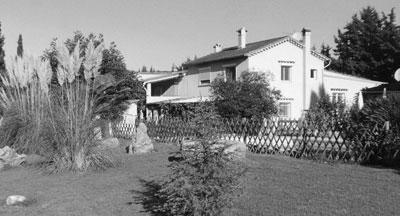Exploring the treasures of Provence
by Paul Richards, Peoria Heights, IL
Good fortune
My wife, Pat, and I are fans of the gîte (pronounced zheet), any of the rental cottages, apartments, villas and chalets available throughout France.
In 2005, with the dumb luck of the trusting traveler, we were delighted to find that the gîte we had rented for 10 days was in the heart of an eclectic vacation landscape near the village of Villecroze, in the Haut Var region of Provence.
Just an hour west of the Nice airport via autoroute A8, and 15 minutes north on the D10, we found a sylvan launching pad to more diversity than we had any reason to expect, and it was great!
Our gîte, Les Suis (phone +33 494 70 76 98, fax +33 494 70 67 31, www.gite-rural-provence.com), was a 4-star apartment with two bedrooms (one with a balcony), a fully equipped kitchen, a large dining area and a laundry room. The late-season rate was $540 a week, linens and utilities included. The rooms were immaculate and the furnishings, tasteful — a tribute to our hosts’ attention to detail.
The gîte’s owners, Hans-Jörg and Maya Stalder-Rey, are truly a couple for all seasons. Hans-Jörg, a former marathon winner and Swiss Army officer, has won gold awards for his Arabian horses in the equestrian shows of Paris and other leading European cities. Today, he plays guitar, loves American blues music and tends the acreage as well as the six Arabians remaining from those they bred in the years before Provence beckoned.
Maya, a vibrant outdoor lady, is an accomplished equestrienne who has ridden her Arabian mares in endurance rides in France and Switzerland. Today, she revels in riding her prize steed Western-style on the trails that lace the area, and loves mushroom hunting, hiking and line dancing. She also proved to be a ready source of information on the area’s points of interest.
The variety we found in the surrounding area had two common characteristics. First, it spanned the spectrum, from ultrachic (the Riviera, of course) to pristine and outdoorsy, with some quaint and artistic thrown in; second, it was all within minutes rather than hours. Here are a few examples.
Line dancing and “Liebestraum”
At Maya’s invitation, we sat in on her weekly line-dancing lesson in the Villecroze assembly hall. Watching a score of French ladies and gents in cowboy hats, kerchiefs and jeans boot-scootin’ through The Wanderer and The Electric Slide, we felt we were in the midst of a true “cross-cultural” experience. It was interesting to hear the instructor leading the group not with “One, two, left, right” but “Un, deux, gauche, droit” — Provence meets “Austin City Limits.”
One evening, in the village’s Saint-Victor chapel, we attended an evening of classical piano by students at L’Académie musicale de Villecroze. Established in 1981, the privately endowed summer academy housed 120 students from 27 countries in 2004 for concert-level studies in over a dozen musical disciplines.
The music of the earnest and talented students seemed, to our appreciative ears, flawless. Chopin, Liszt and Bach never had a more pastoral setting than there among the olive trees and vineyards of rural Provence.
Riviera revisited
An hour south of our gîte was, yes, the Riviera. We had to revisit it for a day, if only to retouch some bases remembered from past trips. So we drove its main artery, the N98, from Frejus to St. Tropez, stopping along the way for an aperitif and to watch a game of pétanque (known as French bocce) next to the yacht harbor in St. Maxime. We also took time to relax at a sidewalk café in St. Raphaël, where the people-watching is first class.
Lunch tip — in La Foux, on the turnoff to St. Tropez, the Cafétéria Casino offers islands of food and drink at the lowest prices we found anywhere in Provence. A typical meal, including entreé, salad, side dish, drink and dessert, cost about $18.
We finished the day by yacht-watching in St. Tropez but came away disappointed by the crushing crowds and blatant commercialism — a far cry from the fishing village of pre-Brigitte Bardot times. This full day still allowed us to return to home base in time for dinner. Like I said, things are close.
Where the river runs
In striking contrast to the gloss of the Côte d’Azur, a scant 15 miles north of Villecroze lies the Gorges du Verdon. Called the Grand Canyon of Europe (but a fraction the size of ours), its palisades still soar up to 700 meters on either side of the Verdon River. Traversing its sometimes-racing currents is best left to the most experienced boaters.
For much of its length, the Verdon flows between narrow cliffs with no exit before emptying into the Lac de Sainte-Croix. The dozen hiking trails that traverse the gorge’s rims, tunnels and galleries are made for hikers more stalwart than we, so we admired their skill through our binoculars from the relative safety of the road that traces its southern rim. We traveled it for 15 miles, starting at the village of Aiguines and stopping at the lookout points for the stunning views. Suffice to say, it is a world apart from the Riviera.
At the canyon’s southern end lies Lac de Sainte-Croix, 5,400 acres of blue-water fishing, kayaking, snorkeling and canoeing. Its broad expanse and miles of accessible beaches, our hosts told us, hold throngs of summer visitors with plenty of stretch-out room for all. I could easily imagine that, as we picnicked on an enormous expanse of sugar-sand beach, enjoying the late autumn wind riffling the waters and exchanging waves with the few hardy kayakers.
Unspoiled beauty at walking speed
Farther to the south, below the lake and its dam, a placid branch of the Verdon eases through its own mini-gorge, quiet as a millpond. Here, we found waters truly made for Sunday sailors.
We rented a 2-passenger electric boat at the village of Quinson (€22 for an hour or €54 for three hours) and glided between its stony cliffs at the speed of a good sidestroker, enveloped in silence broken only by the distant voices of hikers along the rim and the call of the river birds nesting in the high rock niches.
We passed two skiffs of fishermen who obligingly pulled their bobbers aside for us. In an hour, we had passed no more than a half dozen other boaters, always with the friendly wave of fellow voyagers.
Our visit was in late September, but the river’s width of 200 meters and more could safely hold summer crowds, all moving at a less-than-breakneck 2 mph. If dictionary writers need a definition for peaceful, a picture of this stretch of the Verdon would sum it up perfectly.
If you have a liking for history, be sure to visit the Museum of Prehistory (Route de Montmeyan) at Quinson. We spent a fascinating two hours there and still only viewed a fraction of the 400,000 items on display.
Opened in 2001, the museum contains half-million-year-old artifacts found in La Baume Bonne grotto at Quinson, bearing witness to the age of this system of gorges — and testimony to the flourishing prehistoric culture that existed there. Admission is €7 (adults).
Villages: the heartbeat of Provence
For Pat and me, the French village is the hub and heart of the culture we find so appealing. Far from the aplomb and pace of Paris, villages preserve the unique cadences of French provincial life.
A dozen typical villages lay within 15 to 45 minutes of the Villecroze gîte, and we visited them all, some often. They lazed on most days but came alive with activity on the weekly market day. Their cafés and brasseries were an unfailing source of the honest, herb-seasoned cuisine that Provence is famous for.
Here is a sampling of four that charmed us, along with the distance of each from our Villecroze starting point.
Cotignac
We visited Cotignac, eight miles from our gîte, several times, partly because it boasted a tabac that carried the English-language Herald Tribune, a must for keeping up on happenings in the “outside” world.
Cotignac has two impressive features. One is the towering cliffs that overlook the village which reputedly gave Cotignac its name, derived from the Celtic word for “rock.” You can still visit the remains of a fortress built into the stone cliffs by the founding Romans. The other striking feature is the long, wide promenade, elevated above street level, shaded by towering sycamores and lined with shops, restaurants and cafés.
You can lunch at tables under the promenade’s trees, as we were doing at Café du Cours when a light rain began to fall. The other diners all moved into the restaurant, but Pat and I, in a c’est la vie mood, raised our umbrella and continued eating. This was not good enough for the madame restaurateur, however. She emerged from the restaurant carrying a super-sized beach umbrella and bade us come in, which we did — no arguing with the hostess!
On Tuesday, Cotignac’s weekly market fills the two-football-field length of the promenade and its surrounding streets. The market is a French village institution, as much a social event as anything. As euros and products change hands, locals cluster to solve the day’s political problems.
Colorful stands offer produce of the area, household goods, roast chickens, couscous, pastry, wine, clothing… even fresh seafood on tables of ice brought in the morning and packed up and removed by noon.
The Var is olive country, and every village market offers over 20 varieties.
At the Cotignac market, I bought a crystal cube holding an imbedded image of Buddha for €5, which I thought was a bargain. At that price, Pat insisted it must be plastic. Not in my book; it’s crystal and destined for a prominent place in our vitrine.
In the summer, visit the Grainage, which features an array of antiques and Cotignac history. For lunch, try La Table de la Fontaine (27 Cours Gambetta). The tables under the trees are great for enjoying either a full meal or a leisurely café au lait and croissant. Advice — if it rains, move inside.
Tourtour
Unlike most French towns, its name is pronounced like it’s spelled. Four miles from our “home,” Tourtour bears the official rosette of one of 148 plus beaux villages de France (most beautiful villages of France).
Called the “village in the sky,” it’s reached by driving up curvy but well-maintained roads that offer splendid views over lavender fields, pine forests, olive groves, farmhouses, vineyards and far-off villages with their ever-present church steeples.
When arriving at Tourtour itself, resist the temptation to park in the parking lots alongside the road outside the village. Instead, continue under the arch and turn left up toward the restored 19th-century St-Denis Church, where there is usually plentiful parking and a magnificent view. You’ll find the tourist information office up that way, too. The table d’orientation, or marble orientation table, helps you identify distant villages, some almost as far as Aix-en-Provence, 50 miles distant.
The central square is shaded by large olive trees, supposedly replacing elms planted in the 17th century when Anne of Austria stopped on a pilgrimage to Cotignac.
Stone houses line the narrow streets, and fountains sparkled in the sun as we strolled the lanes and passageways of this beautifully preserved village.
You can make your way to two castles, both dating to the Middle Ages; one, refurbished in the 19th century, now houses the mairie (town hall) and post office.
Noon found us in Tourtour, so we chose the restaurant La Farigoulette on the square to have a full lunch (and skip dinner). Farigoulette means “thyme” in the old Provençal language still spoken by many of the elderly in the Mediterranean area.
The restaurant’s rear dining patio looks out over the same far-reaching view as the churchyard. We dined under a shaded overhang, in dappled autumn sunlight, enjoying the admixture of French, English and German conversations around us. In such a setting, the world seemed very far away indeed.
Our three courses, including wine and dessert, came to $58. Yes, restaurants in la belle France are a tad pricey. Brasseries are less so, offering simpler but very adequate menus. We offset our occasional splurge with breakfasts and frequent dinners in our gîte — thank goodness for supermarkets.
Incidentally, we often saw prices written both in euros and francs, which made us wonder if francs were still accepted. Not so. We asked and were told that some people continue to judge value in francs, though they must pay in euros.
Aups
We passed through Aups several times, just five miles from our home gîte, and always stopped for a coffee and beignet.
We also chanced through Aups on Wednesday’s market day and, of course, stopped to sample the atmosphere. The added feature here was street musicians, including a violinist with a cat perched on his shoulder, and a trio who played Beatles and Simon and Garfunkle standards on two transverse flutes and a pan flute (seems odd, sounded great).
Our only meal in Aups was at A La Folie, a sandwicherie, where our table was shielded from the street only by a planter box. But the food was plentiful. Pat’s omelet was at least a 6-egger, which she could not finish (I helped), and my plat du jour of agneau (lamb) took me well past dinner.
Our lunch cost €25 ($30) with rosé — not too bad. And servis in France is compris, which means you need not feel guilty if you don’t tip.
While eating, we watched a beautiful collie stand on his back legs to get a drink from a fountain across the narrow street. Then he sauntered over, eyed me expectantly, accepted a piece of my lamb and moved on. You gotta love sidewalk cafés!
Had we returned to Aups at mealtime, we would have tried one of the restaurants or brasseries on Place Général Girad. Their setting in the shade of a giant sycamore was too perfect to be by chance.
And if we do return, we will give more time to Aups, for the few blocks we strolled led through tantalizing passageways and under arches that had been built by artisans centuries ago. Unfortunately, we were too often passing through on our way to other places.
Moustiers-Sainte-Marie
Moustiers-Sainte-Marie is reached on the D957, after crossing the Pont de Galetas, where the Verdon flows into Lac de Sainte-Croix. This is the most touristique of the villages we visited, having little natural old-world charm.
Even in the first week of October, the upper village was so glutted with people and cars that we settled for lunching in the lower village. Besides, there we found our first €9 plat du jour, and, with the usual 50 cl. pichet of rosé, it was a bargain. (You may sense that we have an eye for economy. You’re right.)
If you are looking for pottery, Moustiers is the village for you. Faience, or locally made ceramics, are sold at myriad shops, and the craftsmanship and beauty of the plates, plaques, vases and tureens were truly impressive. They will mail them to the U.S., but we decided not to risk it.
It was in Moustiers that I made my biggest driving blunder. On my quest for the upper village, I was 300 yards along a narrow street with cars parked bumper to bumper on one side and a stone wall on the other before I realized it was one way, against me, and traffic was coming. Luckily, a tree on one side afforded a little room between cars, so I was able to turn around by seesawing at least a dozen times.
To my relief, the waiting cars did not honk. Later I theorized why. The only time they honk is when they want to make you feel foolish. In this case, they knew I felt foolish and needed no further goading.
Just a little criticism
There are always some problems in paradise, and this time we ran across two.
One was with travelers’ checks. When we tried to cash them in the cities large enough to have national banks — sometimes as many as three — we were refused. They would not cash checks denominated in dollars.
During our whole time there, the only places we could convert our dollar checks into euros were in the Nice airport and at an office of L’Agence (15, Cours Mirabeau) in Aix-en-Provence. We probably could have done so somewhere in the Côte d’Azur, too. If there were any other places, we couldn’t find them, so be advised.
Criticism number two is graffiti. The aerosol-can airheads are taking to spraying their inane scribbles on any flat surface, from city buildings to rural signs, structures, overpasses, barns, etc., anywhere they can reach.
To us, it was disconcerting to be driving through once-unspoiled countryside and see graffiti scrawled on road signs or messages such as “HENRI ’04” on bridge abutments. In our book, anyone caught defacing property with graffiti should be sentenced to a year of weekends removing it.
Summing up
The world is a big place, and other countries and climes may have the diversity we found in Provence. But what we did find there was a new joy every day.
We’ve mentioned the highlights; there were others: the rock climbers outside of Châteauvert, including chattering classes of beginners climbing no higher than a stepladder; the donkey in the sheep meadow, put there because his presence calmed the flock; three border collies moving over 1,000 sheep between pastures; James, the Stalder-Rey’s big black dog, who became our loyal friend for the bites of cheese he collected every evening; the leaden thump of French artillery at a practice range far away in the Luberon Mountains, and the American military cemetery at Draguignan, its snow-white crosses forever at attention.
Every so often, travelers get lucky. They receive far more than they expected. In Provence, that happened to us.

